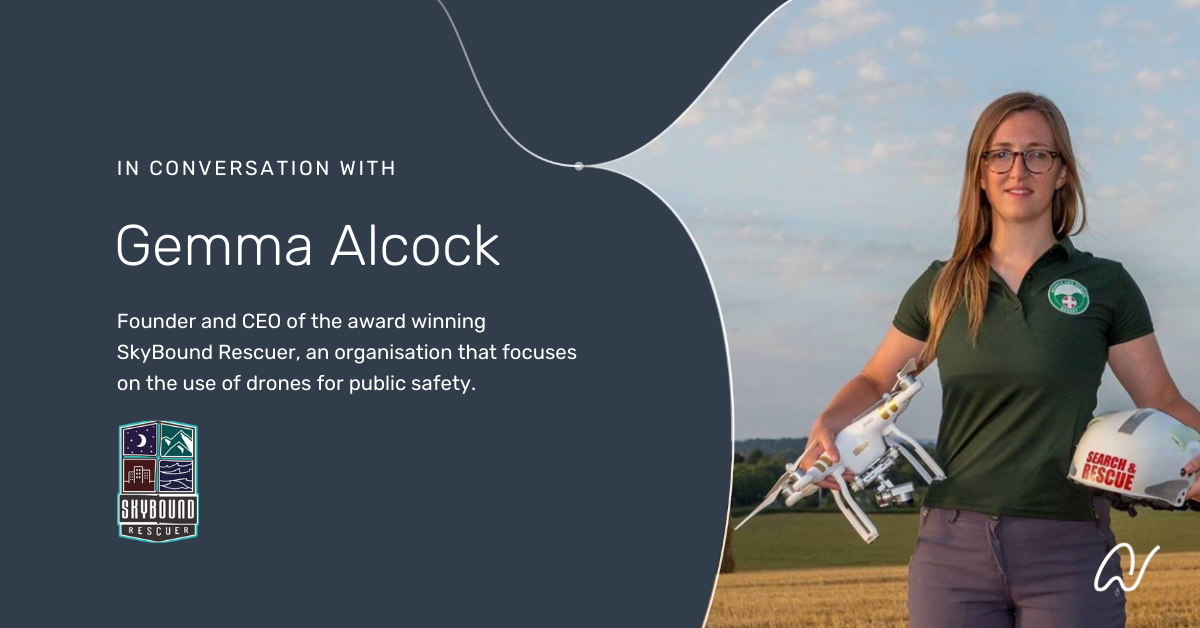In Conversation With
Each month, Airwards chats to someone in the drone industry doing incredible work. We uncover what they do, what makes them tick, where they see the drone industry headed, and discuss positive drone use.
Smit Shah is Director of Partnerships at the Drone Federation of India. He is passionate about public policy and technology integration for scale, and has a history of working in leadership and project management roles for lean businesses.
In our Conversation With Smit, we learn about the most exciting drone use case in India right now, which industries are successfully harnessing drone technology, and how India is working to balance innovation and regulation.
“We are currently mapping out the whole of India using drones! The country has a huge population spanning over 660,000 villages, and each village has anywhere between 10 to 1,000+ families - so this is no small task. Over a four-year timeframe, 1,000 high accuracy, survey grade drones will be used - which, when you boil it down, means we’ll be mapping a quarter of the country each year.”
1 | What are India’s current drone regulation focuses?
In March 2021, the Indian government published the UAS Rules 2021 that were largely met with criticism for the regulation heavy constitution. However, the government was quick to review the feedback and soon moved from a control and licence focused regime to a trust-based regulatory regime for drones, with the Draft Drone Rules 2021. The new rules are aimed towards easing the drone operations in the country and, hopefully, provide a fresh start to enable the drone industry to focus on innovation and research.
With the recently published rules, we have gone a step further in India by ensuring that there are no permissions required for the flights in the ‘green zone’ (i.e. a zone defined for aviation safety up to 400 feet AGL in uncontrolled airspace). That said, permissions are still needed for the unmanned flights in the ‘yellow’ and ‘red’ zone to take off, in order to ensure safety against possible collisions with other flying objects.
2 | In your opinion, what is the most exciting drone use case in India right now?
It doesn’t get much better than this: we are currently mapping out the whole of India using drones! This is a four-year programme, called SVAMITVA Yojana, conducted by the national mapping agency, Survey of India - and it’s no small task. India has a huge population spanning over 660,000 villages, and each village has anywhere between 10 to 1,000+ families. And historically, our rural property tracking system has been conducted on paper…
Many families have lived in the same villages for hundreds of years; it’s their ancestral home, and everyone in the village knows their house is theirs. But, in the current system, there has been no piece of paper to prove that; it has simply belonged to a family for generations without any documentary evidence whatsoever.
However, as times are changing and aspirations are growing, more and more people are starting businesses - and this requires financial support. Someone may own a house worth $10,000, but without proper proof for the banks, they’re unable to secure a loan against their land. So in order to bring financial stability to the citizens in rural India by converting their property into a financial asset, the Indian Government came up with a national scheme to survey every single village using drone technology, and issue digital property cards.
3 | Mapping out the whole of India using drones - wow! How exactly does this work?
Two teams are deployed: a ground team and a drone team. The ground team physically goes to every village and uses a limestone powder to outline boundaries. It takes about half a day per village. After that, the drone team arrives, flies the drone for around 15 minutes, mapping the entire area. There’s an AI-based algorithm that exactly computes the latitude and longitude of each boundary, which creates the basis of each property card. The result is that each person will now have a piece of paper that proves the value of their homes!
This is happening for each and every house in the 660,000+ villages all over India - and it’s certainly the largest drone use case we currently have. 1,000 high accuracy, survey grade drones will be used over the four-year timeframe - which, when you boil it down, means we’ll be mapping a quarter of the country each year.
4 | What other industries are harnessing drone technology in India?
Right now, the industry with the largest drone use is Homeland Security and Defence. However we’re witnessing a rapid adoption for drone technology in agriculture and mining, as well as infrastructure development. In fact, all of our new roads are using drone-based surveying and progress monitoring. A lot of drone-dependent operations are also happening on the Smart Cities initiative - a large government initiative launched by the PM, Narendra Modi. This programme will see 100 cities becoming commercially profitable from their own revenue, which is pretty exciting. So a lot of drones are being used for accurate property taxation and public utility management.
Both public and private sector organisations have started adopting drones for applications such as crop health monitoring, asset inspections, construction progress monitoring, mining surveys, and countless other applications. To give you a rough estimate on the industrial progression, India is projected to become one of the largest markets for drones with the Indian drone industry having the potential to generate over 5,00,000 professional jobs in the next 5 years.
5 | How are you balancing innovation and regulation within your region?
Our experience with policy advocacy for the Indian drone ecosystem has taught us that the only way to balance these two and solve the drone problem is by educating the regulators. As a single stakeholder, the government is responsible for creating the regulations. Irrespective of which country you’re in, because drones are a new technology that is being rapidly adopted, they need to be regulated very carefully in order not to suppress research and development.
The regulators can only foster innovation with proper education and training. If you look at manned aviation, it’s been around for 100 years depending on the country you’re from, and it has reinvented itself over that timeframe, not only in terms of technology but operations and adaptation for civilian usage.
This is in stark contrast to the growth acceleration of the drone industry, especially when urban air mobility differs so much from country to country. So we have to keep educating the regulators about the benefits and advantages of drones. That’s how we can and have started to achieve the fine balance of innovation and regulation. To enable this further, we’ve also been pushing forth a lot of government funding programmes, where we are coming up with various challenges, in order to motivate the industry to move forward.
6 | What are your thoughts on Airwards? What are you hoping to see with entries?
With Airwards, we are looking forward to collaborating with the international drone community. We continually liaise with our partners in the US, Europe, Switzerland, Australia and Japan, so we’re excited about the global aspect of the awards programme that recognises the UAV companies striving for excellence. We want to do two things specifically. Firstly, observe what the world is making, to understand the new use cases and bring this information back to Indian companies to take inspiration from. Secondly, we’d like to develop deep international relationships, to empower Indian businesses internationally and reciprocate for foreign manufacturers.
About DFI
The Drone Federation of India (DFI) is a not-for-profit industry-led body, with the singular objective to build a safer and scalable drone industry in India, and accelerate growth of the drone industry. They have five key focus areas: New policy formulation, Operationalising of the existing policies, Trade promotion and industry development, Skill development, Research & standardisation
Connect with Smit Shah on LinkedIn and visit DFI for more information.
















